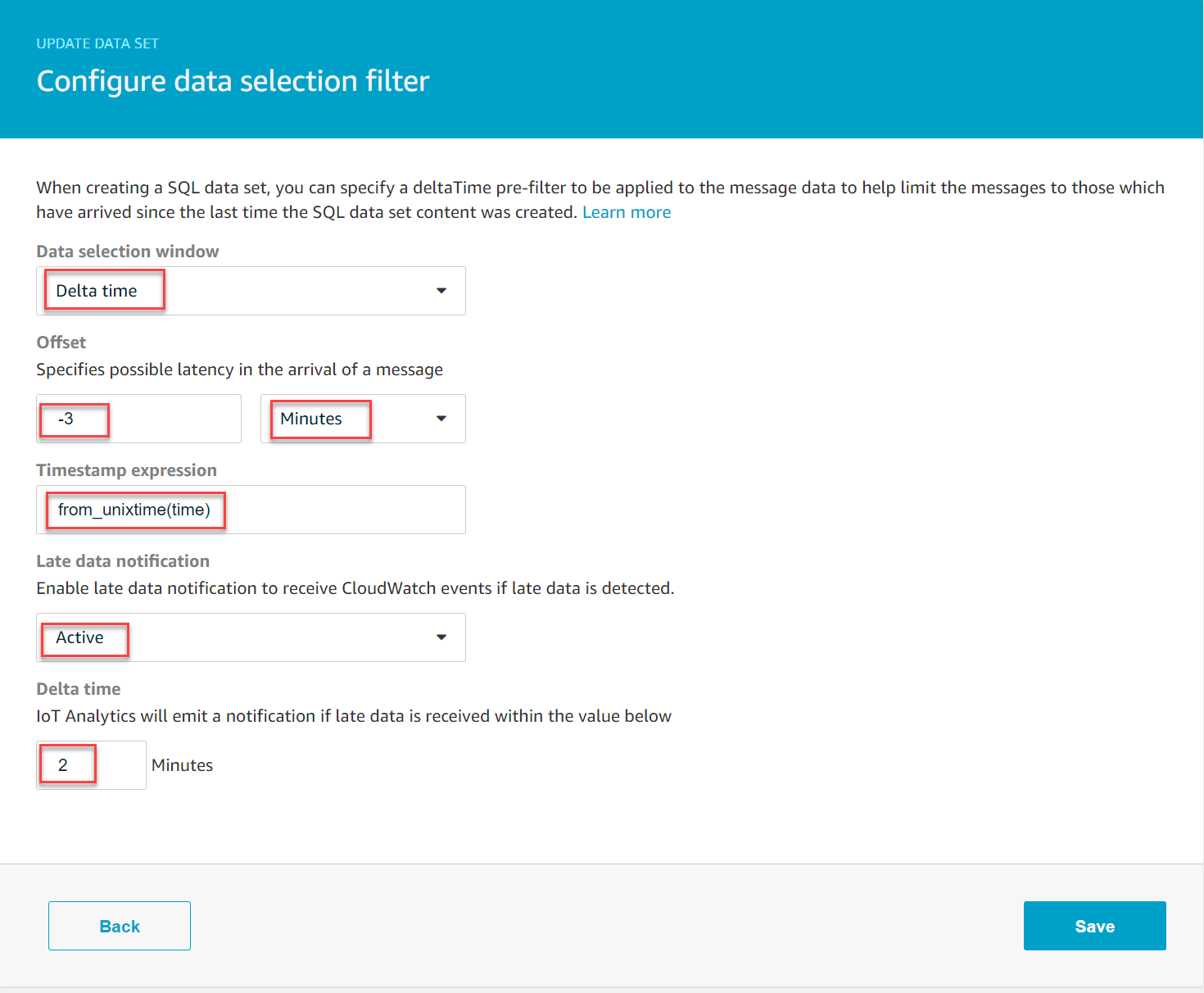终止支持通知: Amazon 将于 2025 年 12 月 15 日终止对的支持 Amazon IoT Analytics。2025 年 12 月 15 日之后,您将无法再访问 Amazon IoT Analytics 控制台或 Amazon IoT Analytics 资源。有关更多信息,请参阅Amazon IoT Analytics 终止支持。
本文属于机器翻译版本。若本译文内容与英语原文存在差异,则一律以英文原文为准。
通过 Amazon Ev CloudWatch ents 获取延迟数据通知
当您使用来自指定时间段的数据创建数据集时,有些消息数据可能无法及时送达处理。为了允许延迟,您可以通过应用queryAction(SQL 查询)来指定创建数据集QueryFilter时的deltaTime偏移量。 Amazon IoT Analytics 仍会处理在 delta 时间内到达的数据,并且您的数据集内容存在时间延迟。数据延迟通知功能 Amazon IoT Analytics 允许在增量时间之后数据到达时通过 Amazon Ev CloudWatch en ts 发送通知。
您可以使用 Amazon IoT Analytics 控制台、API、Amazon Command Line Interface (Amazon CLI) 或 Amazon SDK 为数据集指定延迟数据规则。
在 Amazon IoT Analytics API 中,LateDataRuleConfiguration对象表示数据集的后期数据规则设置。此对象是与 CreateDataset 和 UpdateDataset API 操作关联的 Dataset 对象的一部分。
参数
使用为数据集创建延迟数据规则时 Amazon IoT Analytics,必须指定以下信息:
ruleConfiguration(LateDataRuleConfiguration)-
包含延迟数据规则配置信息的结构。
deltaTimeSessionWindowConfiguration-
包含增量时间会话窗口的配置信息的结构。
DeltaTime 指定时间间隔。您可以通过
DeltaTime使用上次执行后到达数据存储的数据创建数据集内容。有关DeltaTime的示例,请参阅使用增量窗口(CLI)创建 SQL 数据集。timeoutInMinutes-
一个时间间隔。你可以使用
timeoutInMinutessoh 来 Amazon IoT Analytics 批量处理自上次执行以来生成的延迟数据通知。 Amazon IoT Analytics 一次向 CloudWatch 事件发送一批通知。类型:整数
有效范围:1-60
ruleName-
延迟数据规则的名称。
类型:字符串
重要
要指定 lateDataRules,数据集必须使用 DeltaTime 筛选器。
配置延迟数据规则(控制台)
以下步骤介绍了如何使用 Amazon IoT Analytics 控制台配置数据集的延迟数据规则。
要配置延迟数据规则
-
在导航窗格中,选择 数据集。
-
在数据集下,选择目标数据集。
-
在导航窗格中,选择 详细信息。
-
在 增量窗口部分中,选择编辑。
-
在配置数据选择筛选条件下,执行以下操作:
-
对于数据选择窗口,选择增量时间。
-
对于偏移,输入一个时间段,然后选择一个单位。
-
对于时间戳表达式,输入一个表达式。这可以是时间戳字段的名称,也可以是可以推导时间的 SQL 表达式,例如
from_unixtime(time)。有关如何编写时间戳表达式的更多信息,请参阅《Presto 0.172 文档》中的日期与时间函数和运算符
。 -
对于延迟数据通知,请选择激活。
-
对于增量时间,请输入一个整数。有效范围为 1-60。
-
选择保存。

-
配置延迟数据规则(CLI)
在 Amazon IoT Analytics API 中,LateDataRuleConfiguration对象表示数据集的后期数据规则设置。此对象是与 CreateDataset 和 UpdateDataset 关联的 Dataset 对象的一部分。您可以使用 API、Amazon CLI、或 Amazon SDK 为数据集指定延迟数据规则。下面的示例使用了 Amazon CLI。
要使用指定的延迟数据规则创建数据集,请运行以下命令。以下命令假定该 dataset.json 文件位于当前目录中。
注意
您可以使用 UpdateDatasetAPI 更新现有数据集。
aws iotanalytics create-dataset --cli-input-json file://dataset.json
该dataset.json文件应包含以下内容:
-
demo_dataset替换为目标数据集名称。 -
demo_datastore替换为目标数据存储名称。 -
from_unixtime(time)替换为可以推导时间的时间戳字段或 SQL 表达式的名称。有关如何编写时间戳表达式的更多信息,请参阅《Presto 0.172 文档》中的日期与时间函数和运算符
。 -
timeout替换为 1—60 之间的整数。 -
demo_rule用任意名称替换。
{ "datasetName": "demo_dataset", "actions": [ { "actionName": "myDatasetAction", "queryAction": { "filters": [ { "deltaTime": { "offsetSeconds":-180, "timeExpression": "from_unixtime(time)" } } ], "sqlQuery": "SELECT * FROMdemo_datastore" } } ], "retentionPeriod": { "unlimited": false, "numberOfDays": 90 }, "lateDataRules": [ { "ruleConfiguration": { "deltaTimeSessionWindowConfiguration": { "timeoutInMinutes":timeout} }, "ruleName": "demo_rule" } ] }
订阅接收延迟数据通知
您可以在 “ CloudWatch 事件” 中创建规则,定义如何处理从中发送的延迟数据通知 Amazon IoT Analytics。当 Ev CloudWatch ents 收到通知时,它会调用规则中定义的指定目标操作。
创建 CloudWatch 事件规则的先决条件
在为创建 CloudWatch 事件规则之前 Amazon IoT Analytics,应执行以下操作:
-
熟悉事件中的事件、规则和目标。 CloudWatch
-
创建和配置您的 CloudWatch 事件规则调用的目标。规则可调用多类目标,例如:
-
Amazon Kinesis 流
-
Amazon Lambda 函数
-
Amazon Simple Notification Service(Amazon SNS)主题
-
Amazon Simple Queue Service(Amazon SQS)队列
您的 CloudWatch 事件规则和关联目标必须位于您创建 Amazon IoT Analytics 资源的 Amazon 区域。有关更多信息,请参阅 Amazon Web Services 一般参考 中的服务端点和配额。
-
有关更多信息,请参阅什么是 CloudWatch 事件? 以及《亚马逊 CloudWatch 活动用户指南》中的 “亚马逊 CloudWatch 活动入门”。
延迟数据通知事件
延迟数据通知的事件使用以下格式。
{ "version": "0", "id": "7f51dfa7-ffef-97a5-c625-abddbac5eadd", "detail-type": "IoT Analytics Dataset Lifecycle Notification", "source": "aws.iotanalytics", "account": "123456789012", "time": "2020-05-14T02:38:46Z", "region": "us-east-2", "resources": ["arn:aws:iotanalytics:us-east-2:123456789012:dataset/demo_dataset"], "detail": { "event-detail-version": "1.0", "dataset-name": "demo_dataset", "late-data-rule-name": "demo_rule", "version-ids": ["78244852-8737-4650-aa4d-3071a01338fa"], "message": null } }
创建 CloudWatch 事件规则以接收延迟的数据通知
以下过程向您展示如何创建向 Amazon SQS 队列发送 Amazon IoT Analytics 延迟数据通知的规则。
创建 CloudWatch 事件规则
-
在导航窗格中的 Events(事件)下,选择 Rules(规则)。
-
在 规则 页面,选择 创建规则。
-
在事件源下,选择事件模式。
-
在生成事件模式以按服务匹配事件部分,执行以下操作:
-
对于服务名称,请选择 IoT Analytics
-
对于事件类型,请选择 IoT Analytics 数据集生命周期通知。
-
选择特定数据集名称,然后输入目标数据集的名称。
-
-
在目标下,选择添加目标*。
-
选择 SQS 队列,然后执行以下操作:
-
对于队列*,选择目标队列。
-
-
选择 Configure details(配置详细信息)。
-
在 步骤 2:配置规则详细信息 页面上,输入名称和描述。
-
选择创建规则。